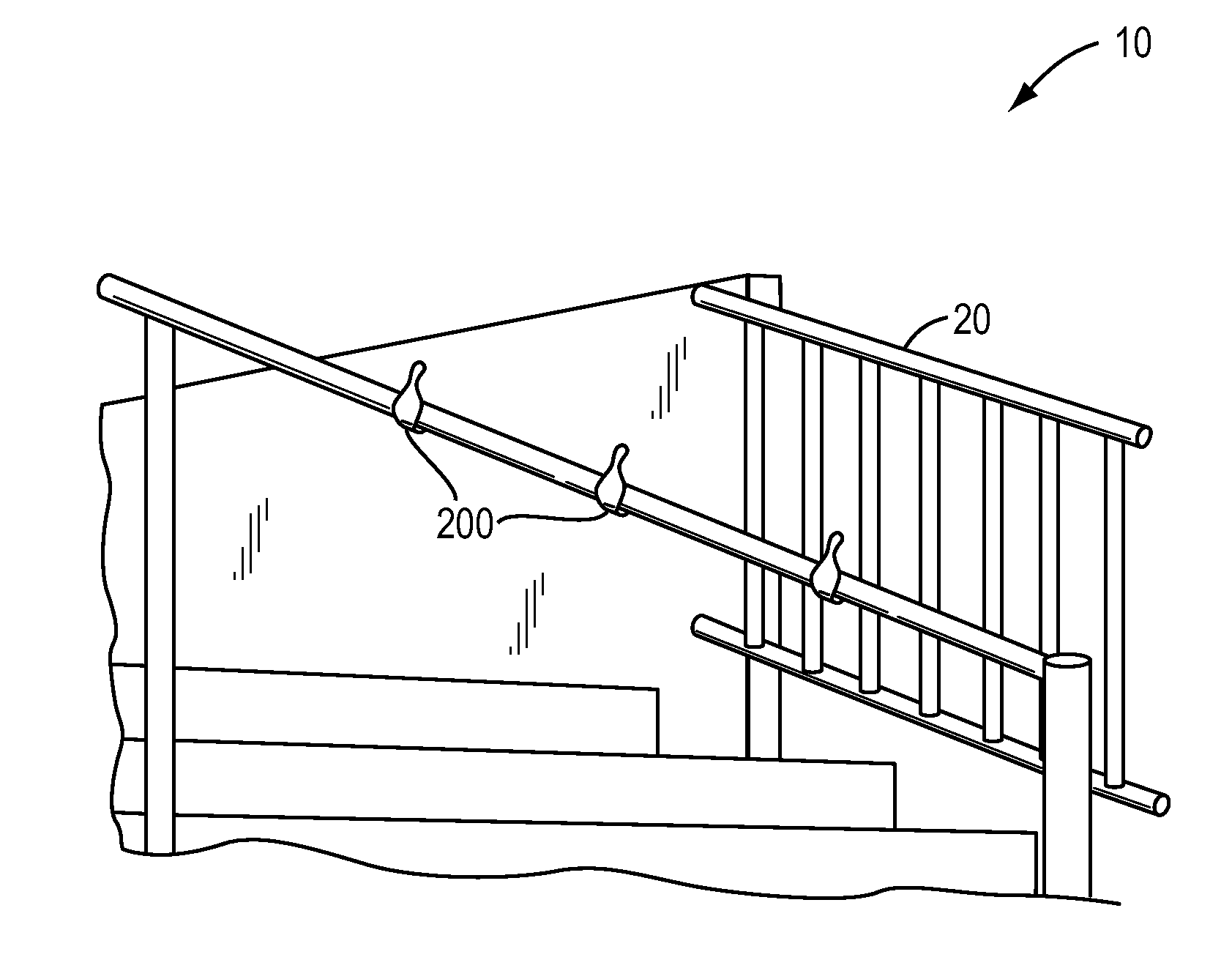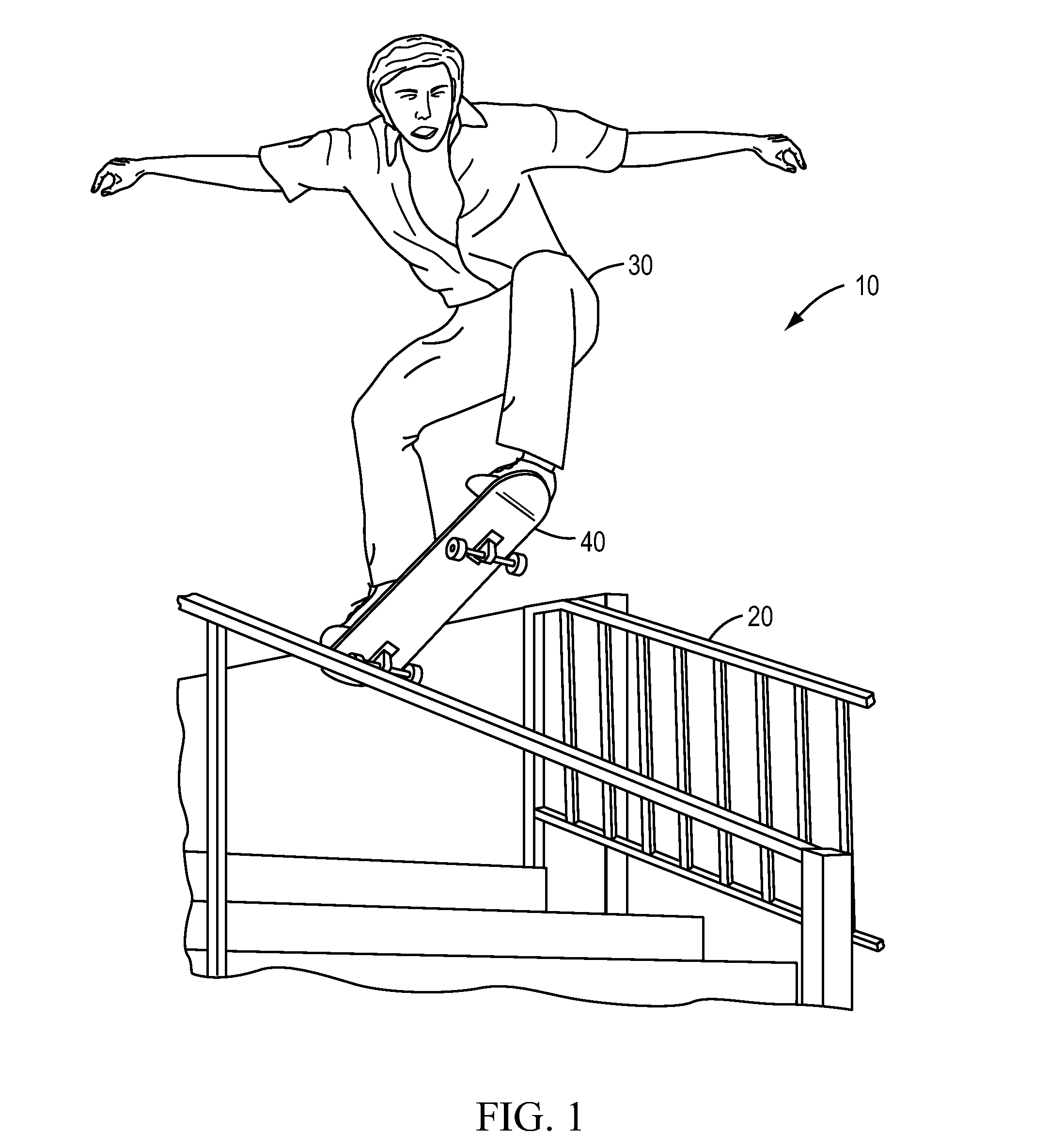Handrail for staircase or ramp
- Summary
- Abstract
- Description
- Claims
- Application Information
AI Technical Summary
Benefits of technology
Problems solved by technology
Method used
Image
Examples
embodiment 200
[0020]The embodiment 200 in FIG. 4A and FIG. 4B includes an elongated cylinder 110 and an arcuate riser barrier 210 with a proximal end 220 and a distal end 224. The proximal end 220 is adapted for affixation to the bottom of the elongated cylinder 110 by conforming its curvature approximately to the curvature at the bottom of the elongated cylinder. The proximal end 220 is affixed to the elongated cylinder 110 by means of tack welds 222 at points on either side of the cylinder 110 nearest to the proximal end 220 of the barrier 210. The arcuate riser barrier 210 extends laterally and rises vertically so that the distal end 224 is spaced horizontally away from the elongated cylinder 110 by dimension “d”, and vertically away by dimension “e”. In one version, dimension “d” is approximately 1½ inches and dimension “e” is approximately 3 inches. As the arcuate riser barrier 210 rises from its proximal end 220 to its distal end, the riser barrier widens and then narrows. The arc-shaped ar...
embodiment 300
[0021]The embodiment 300 in FIGS. 5A and 5B includes an elongated cylinder 110, and a riser barrier having extender portion 320 and riser portion 310. The extender portion 320 is curved downward between the proximal end 330 and the distal end 340 and holds the elongated cylinder 110 away horizontally from the riser portion 310 by dimension “k” and vertically away by dimension “p”, where, in one embodiment, dimension “k” is about 1½ inches and dimension “p” is about 1½ inches. The horizontal separation between the riser portion 310 and cylinder 110 permits the user to slide his / her hand along the cylinder 110 without interference, the downward curve of the extender portion 320 giving added room for the user's hand. The length of the riser portion 310 deters the skateboarder from sliding on the rail. As shown in the figures, the riser portion 310 has a thickness given by dimension “j”, which in one version is about ½ inch and a width given by dimension “n”, which in one version is abo...
embodiment 400
[0022]The embodiment 400 in FIGS. 6A and 6B includes an elongated bar 112 and a riser barrier having extender portion 320 and riser portion 310. The elongated bar 112 is generally rectangular or square in cross-section and may be hollow (shown) or solid. The extender portion 320 of the riser barrier is curved downward between the proximal end 332 and the distal end 340 and holds the elongated bar 112 away horizontally from the riser portion 310 by dimension “k” and vertically away by dimension “p”, where, in one embodiment, dimension “k” is about 1½ inches and dimension “p” is about 1½ inches. The horizontal separation between the riser portion 310 and bar 112 permits the user to slide his / her hand along the bar 112 without interference, the downward curve of the extender portion 320 giving added room for the user's hand. The length of the riser portion 310 deters the skateboarder from sliding on the rail. As shown in the figures, the riser portion 310 has a thickness given by dimen...
PUM
 Login to View More
Login to View More Abstract
Description
Claims
Application Information
 Login to View More
Login to View More - R&D
- Intellectual Property
- Life Sciences
- Materials
- Tech Scout
- Unparalleled Data Quality
- Higher Quality Content
- 60% Fewer Hallucinations
Browse by: Latest US Patents, China's latest patents, Technical Efficacy Thesaurus, Application Domain, Technology Topic, Popular Technical Reports.
© 2025 PatSnap. All rights reserved.Legal|Privacy policy|Modern Slavery Act Transparency Statement|Sitemap|About US| Contact US: help@patsnap.com



